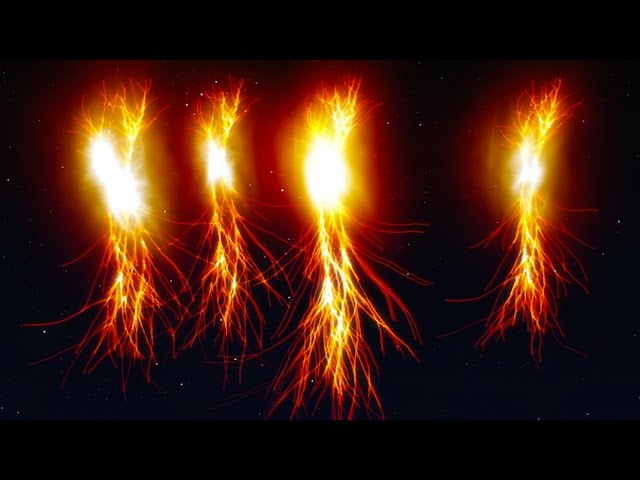What Are Sprites? Sprites stand as the pioneers among Transient Luminous Events (TLEs), a phenomenon steeped in centuries-old tales of ethereal lights cavorting over storm clouds.
However, their scientific recognition only dawned in 1989 when researchers serendipitously captured one on film.
The serendipitous event occurred during camera testing for an upcoming rocket mission at the University of Minnesota.
Sprites typically exhibit a reddish hue, with hints of blue adorning their lower edges, showcasing both diffuse plumes and brighter tendrils reminiscent of carrots or jellyfish.
Stretching anywhere from 40 to 80 kilometers (25 to 50 miles) above the Earth’s surface, a single sprite dwarfs the clouds that birthed it, which typically hover around 15 kilometers (9 miles) in altitude.
Despite their considerable dimensions, sprites flash into existence for mere thousandths of a second, rendering them elusive to the naked eye without sensitive nocturnal cameras.
They are caused by intense cloud-to-ground lightning.
This lightning induces a transfer of electric charge, generating a formidable electric field around the strike zone.
At the lofty heights above storm clouds, the sparse air density permits this field to trigger an electrical discharge akin to conventional lightning, albeit within the atmosphere.
These discharges excite air molecules, prompting them to emit light. In the upper reaches of sprites, red light predominates, emanating primarily from nitrogen molecules. Conversely, blue light, derived from nitrogen molecules and ions, dominates the lower regions of sprites.
Jets: Illuminating the Skies Above Storms
In an unexpected turn of events in 1994, two aircraft encountered a novel phenomenon while observing sprites above storms sweeping across the U.S. Midwest.
This newfound Transient Luminous Event (TLE) was dubbed a blue jet—an inverted, cone-shaped cascade of light erupting from the summits of storm clouds.
Blue jets essentially represent lightning strikes that defy convention by surging skyward from within their parent clouds.
Within the stratosphere, their electrical energy stimulates nitrogen molecules, casting a distinctive blue glow that characterizes these phenomena.
Typically spanning altitudes from the cloud tops, around 15 kilometers (9 miles) high, to heights ranging between 30 to 40 kilometers (20 to 25 miles), these jets manifest in varying sizes.
Smaller versions, known as “blue starters,” extend just a few kilometers above the clouds, while more potent iterations ascend to altitudes of approximately 80 kilometers (50 miles), earning the moniker “gigantic jets.”
Gigantic jets, a rare spectacle, appear to occur more frequently in tropical regions.
Indeed, gigantic jets often exhibit red-tipped extremities, indicative of their ascent to altitudes where nitrogen emits a red hue, mirroring the coloration seen in sprites.
In 2021, researchers disclosed that instruments aboard the International Space Station (ISS) had afforded the initial clear glimpse of the ignition point of a blue jet—a fleeting burst of blue-hued electricity near a cloud apex lasting a mere 10 millionths of a second.
Subsequent observations from ISS cameras unveiled a continuous crackling of blue sparks atop thunderclouds, termed corona discharges, elucidating the genesis of blue jets within these electrified environments.
ELVES, Ghosts, and Other Enigmatic Glows
In the 1990s, a new chapter in the exploration of transient luminous events (TLEs) unfolded with the revelation of a third type: ELVES.
The term ELVES, an acronym for “emission of light and very low frequency perturbations due to electromagnetic pulse sources,” denotes these fleeting phenomena.
ELVES manifest as swiftly expanding rings of light approximately 90 kilometers (55 miles) above the Earth’s surface, sprawling to encompass hundreds of kilometers in width before vanishing in the blink of an eye, lasting less than a thousandth of a second.
Capturing ELVES poses a challenge due to their rapidity, often necessitating specialized equipment for observation.
Analogous to sprites, ELVES are instigated by intense lightning discharges.
A very powerful lightning discharge generates this very [strong] electromagnetic pulse.
The pulse assumes a spherical shape, emanating outward from the lightning strike.
Within the atmosphere, at an altitude ranging from 80 to 90 kilometers (50 to 55 miles), this pulse energizes electrons, inducing collisions with nitrogen atoms and prompting the characteristic red glow.
However, the pulse’s ability to engender luminosity is confined to a specific atmospheric layer, resulting in the distinctive ring-shaped appearance of ELVES.
As the spherical pulse expands, it traverses a broader swath of the atmosphere, slicing through the region where nitrogen can be stimulated to radiate light.
Of all TLEs, ELVES boast the most comprehensive understanding, yet citizen scientists and researchers continue to unearth novel TLE variants for investigation.
Recent advancements have shed light on the atmospheric components responsible for the spectral glow of ghosts.
While oxygen contributes to the luminosity, akin to the green hues observed in certain auroras, minuscule traces of iron and nickel also play a role.
These airborne particulates likely stem from cosmic dust particles intersecting Earth’s atmosphere, elucidating the spectral palette of these fleeting apparitions.
(Inputs from snexplores)









Comment